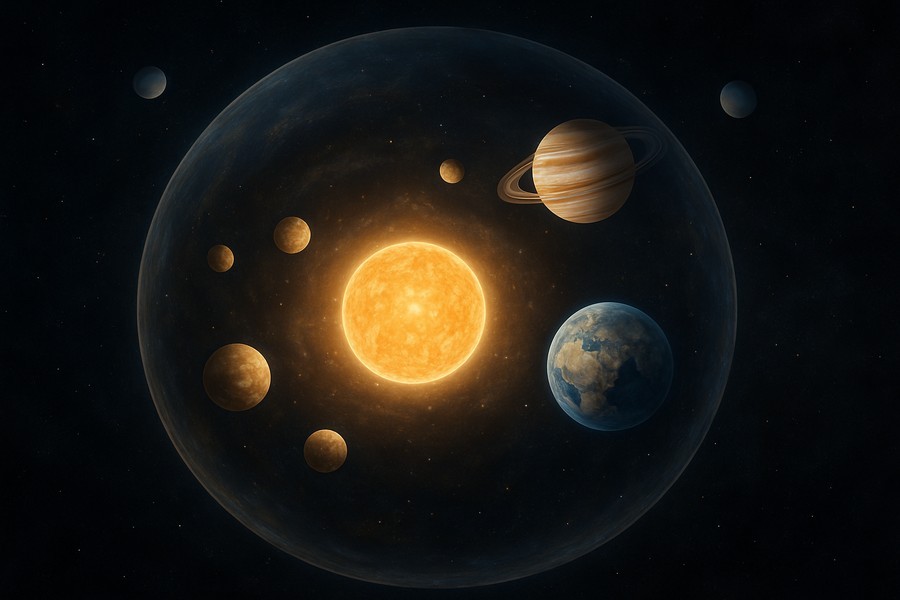
Understanding the Life-Sustaining Cosmic Bubble
There's an incredible structure known as the "heliosphere" that wraps our solar system in a protective bubble. A new mission is set to venture close to the Sun to learn more about this life-preserving cosmic force.
Created by the Sun, the heliosphere safeguards Earth and its planetary siblings from lethal cosmic radiation that speeds through space at light speed. This shield allows life on our vibrant blue planet to flourish and prosper.
The Solar Engine behind the Heliosphere
The Sun ceaselessly emits blasts of charged particles such as protons, electrons, and ions at velocities exceeding a million miles per hour. This tremendous flow, known as the solar wind, expands the heliosphere, causing it to inflate billions of miles outward.
Although Earth has its own protective magnetic field, it only shields our planet. For everything else in the solar system, the heliosphere does the heavy lifting.
The Mission to Explore the Heliosphere
A space probe named IMAP was launched to conduct a comprehensive study of the heliosphere. The probe will gather data about the heliosphere, solar wind, radiation, magnetic fields, and other space weather conditions for two years.
William H. Matthaeus, a physicist specializing in the Sun's magnetic field and solar wind, is a key player in this mission. His work contributed to the design of the magnetic field instrument aboard IMAP.
Key Questions for the Mission
The mission primarily seeks to understand how solar particles gain such high energy and how our solar system interacts with the broader galaxy. To help answer these questions, IMAP carries ten different instruments. It will also study minuscule particles known as cosmic dust, which originate beyond our solar system.
Understanding these aspects is crucial to designing missions that can better withstand space conditions and to protect future astronauts venturing to the Moon or Mars.
IMAP's Observation Point
Space weather has tangible effects on Earth, impacting satellites, radio communication, power grids, and even astronaut safety. IMAP will station itself at a location known as Lagrange Point 1, or L1. This point, about 1 million miles from Earth towards the Sun, is a prime spot for observing space weather as Earth and Sun's gravity balance out there.
Two additional spacecraft will accompany IMAP. One will focus on observing changes in Earth’s outermost atmosphere, and the other will track the solar wind and massive energy eruptions from the Sun's surface that can disrupt life on Earth.
More Spacecraft, More Discoveries
L1 already hosts five other spacecraft, and the addition of more is an exciting prospect. The simultaneous presence of several spacecraft will enable the measurement of three-dimensional structures of shocks, coronal mass ejections, and turbulence.
IMAP's Unique Capabilities
IMAP will have the unique ability to detect energetic neutral atoms heading towards Earth. These atoms are distinctive as they lack a charge, meaning magnetic fields do not affect them. They travel in straight lines, simplifying the task of determining their origin.
IMAP carries three instruments specifically for detecting these particles, which will assist scientists in mapping the heliosphere and areas of space we've yet to comprehend.
However, this mission isn't merely about collecting data. It aims to understand the workings of our solar system and its connection to the surrounding galaxy.
Expectations from the Mission
Nicky Fox, associate administrator for a prominent space agency, expressed optimism about the mission. "We are going to find incredible new discoveries. We're excited about the applications. But the actual discovery science is going to literally rewrite textbooks and that’s why we’re so excited about it."
Matthaeus added, "We intend to be part of that rewrite – not just me, but my students and postdocs. I always tell them, 'Don’t just look over your shoulder. Try to do something nobody else has done before."
